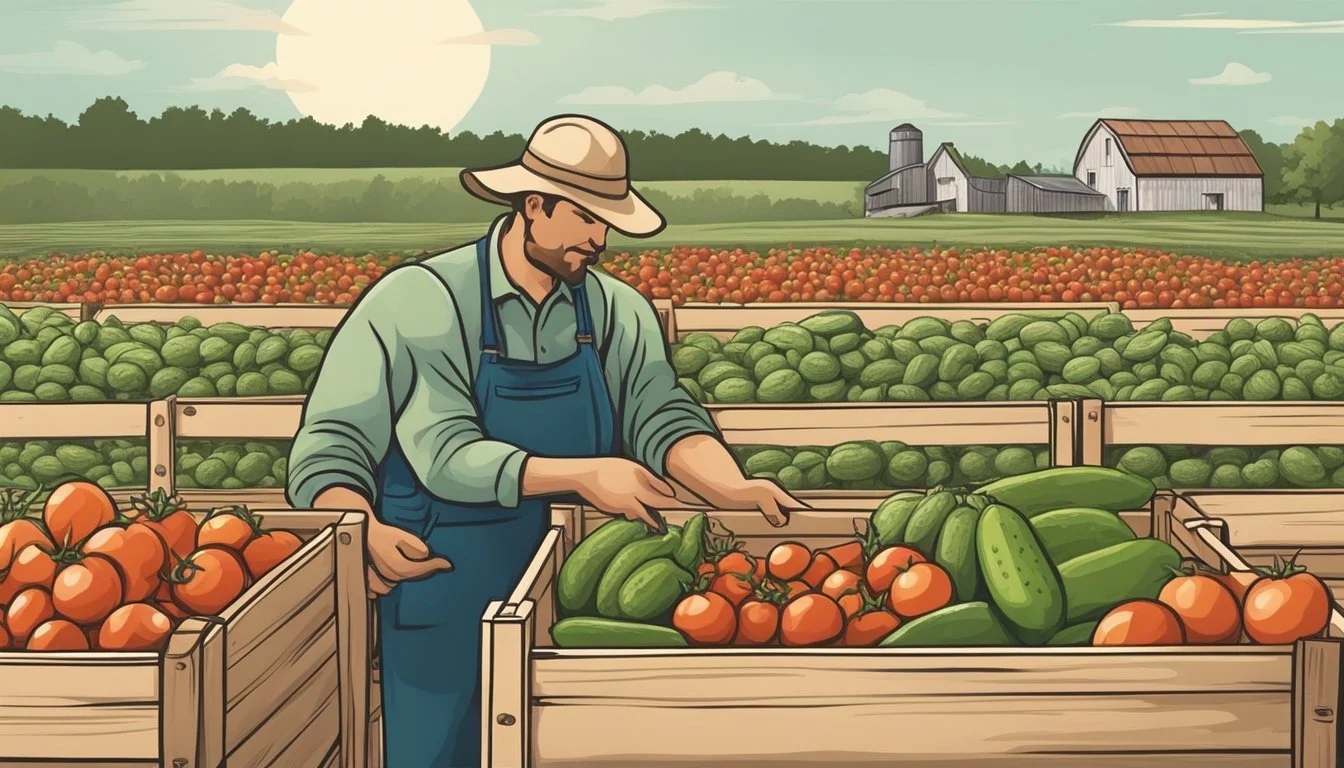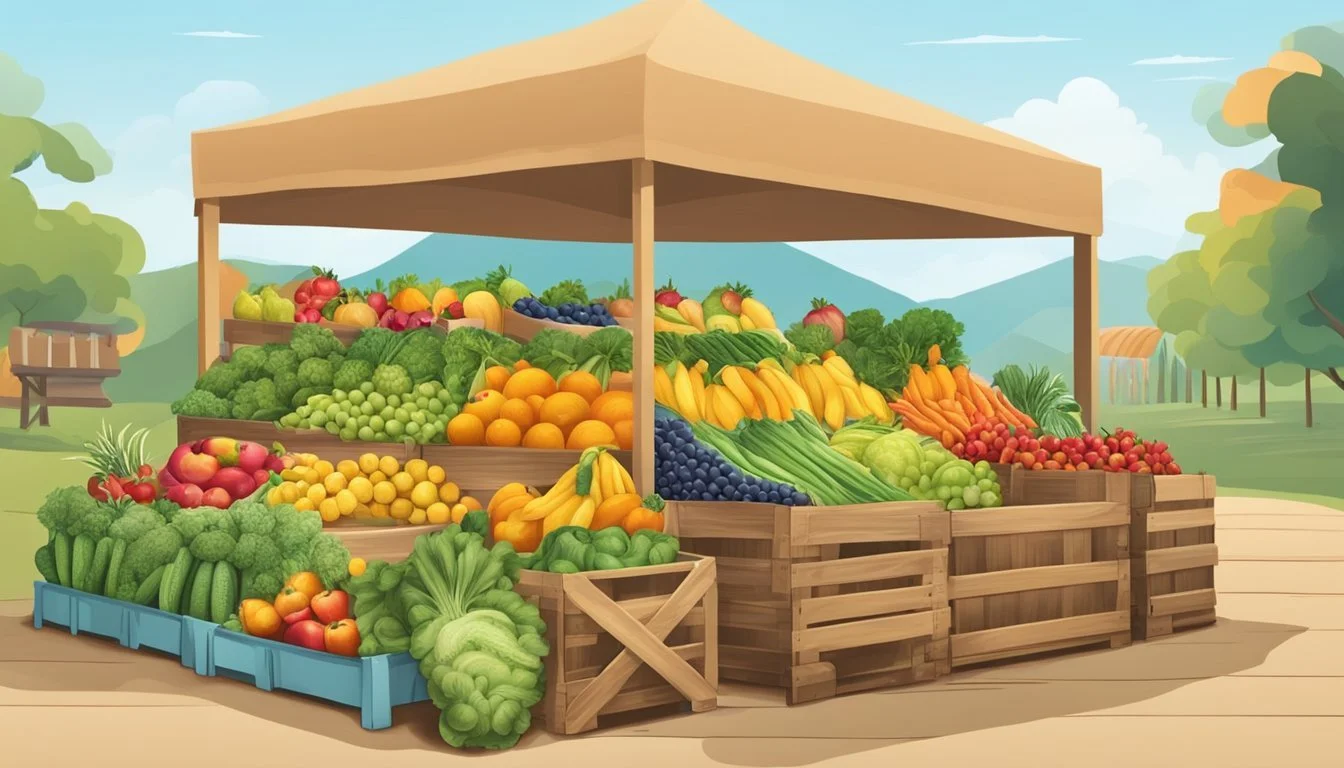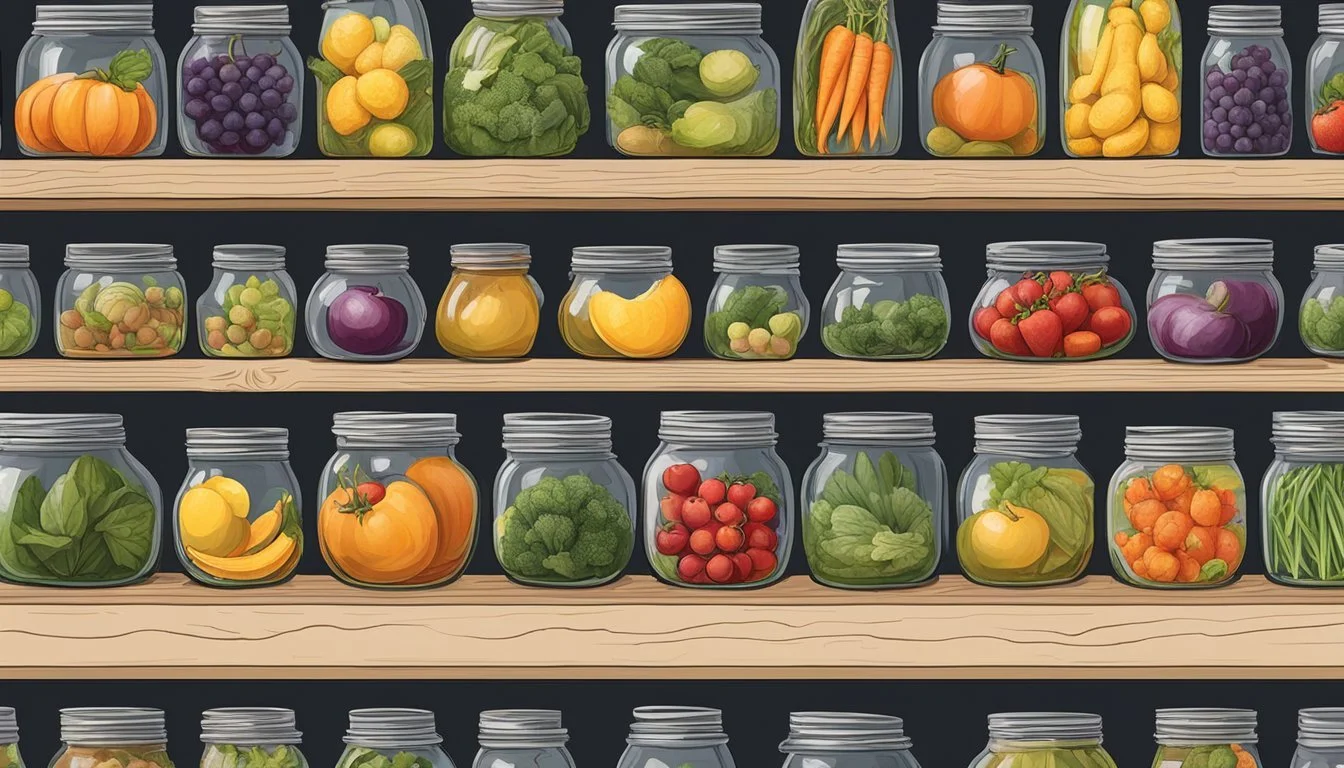Maryland Seasonal Fruit & Veg Guide
Your Year-Round Companion
Maryland's diverse climate and geography, ranging from the Chesapeake watershed to the northern Appalachia, offer a rich array of fresh fruits and vegetables across different seasons. The state prides itself on a farm-to-table ethos that emphasizes the consumption of locally sourced, seasonal produce. This approach not only supports local farmers and the economy but also ensures that residents and visitors get to enjoy the ripest, most flavor-rich produce available.
The changing seasons in Maryland dictate the availability of various fruits and vegetables, with each period offering its own selection. Spring heralds the arrival of tender asparagus (What wine goes well with asparagus?)and crisp greens, while summer brings a bounty of sweet berries, juicy peaches, and plump tomatoes. The fall harvest is rich with apples, pumpkins, and root vegetables, and even winter has its share of fresh offerings, including hearty greens and winter squashes.
Consumers who are attuned to Maryland's seasonal cycles can not only indulge in peak freshness but also experience the nuances in flavor that come with fruits and vegetables at their prime. By integrating this seasonal guide into their shopping habits, individuals can enrich their culinary experiences while contributing positively to the environment by reducing the need for long-distance food transportation.
What’s in Season in Maryland Right Now?
Understanding Maryland's Growing Seasons
Maryland's diverse climate offers a variety of growing conditions, allowing for a rich array of produce throughout the year. Each season boasts its distinct harvests that cater to farm-to-table enthusiasts, ensuring a steady supply of fresh fruits and vegetables.
Spring Harvest
Spring in Maryland begins the cycle of freshness with a selection of nutritious vegetables. Asparagus spearheads the season, followed by an array of leafy greens such as spinach, kale, (What wine goes well with kale?) and lettuce. Root vegetables like turnips and radishes also make their way to the table alongside carrots, while peas add a sweet burst to the mix.
May Harvest:
Asparagus
Beets
Broccoli
Carrots
Lettuce
Kale
Peas
Spinach
Turnips
Summer Abundance
By the time summer rolls in, Maryland's farms are in full swing. July ushers in an abundant harvest of corn, tomatoes, and peppers. The state's warm climate nurtures watermelon and cantaloupe (how long does cantaloupe last?), offering a sweet retreat, while beans, cucumbers (how long do cucumbers last?), and eggplant (What wine goes well with eggplant?) provide versatility for summer dishes. Fruit-wise, peaches and blueberries ripen under the sun, and sweet corn becomes a staple at many meals.
July Peak:
Corn
Tomatoes
Peppers
Watermelon
Beans
Cucumber
Eggplant (What wine goes well with eggplant?)
Peaches
Blueberries
Sweet Corn
Summer Squash
Autumn Harvest
Autumn's cool touch enhances Maryland's produce palette with hearty vegetables and fruits. The harvest includes favorites like pumpkins and a variety of winter squashes, perfect for both decoration and culinary creations. Orchard fruits such as apples and pears reach their peak, while sweet potatoes (What wine goes well with sweet potatoes?) offer a rich, earthy flavor that complements the season's comfort foods.
Fall Favorites:
Apples
Pumpkins
Sweet Potatoes
Pear
Winter Squash
Brussels Sprouts
Cauliflower
Winter Offerings
Winter in Maryland may bring a chill, but it does not halt the availability of fresh produce. Hardy greens like collards thrive, and root vegetables such as parsnips, cauliflower, and leek remain staples. While fresh options are more limited, this is the season where stored, canned, and frozen produce play a significant role in maintaining a local and seasonal diet.
Winter Storage:
Brussels Sprouts
Cauliflower
Parsnips
Radishes
Collards
Leek
Kale (stored/frozen)
Maryland's Fruit and Vegetable Planting Calendar
In Maryland, the vegetable planting calendar is a crucial guide for gardeners. It varies across regions due to differences in climate and frost dates. For instance, frost-free days range from 150 in western regions to 225 on the lower eastern shore. Gardeners can grow a wide variety of warm and cool-season crops with proper planning.
Spring planting typically begins as the danger of frost passes. Here's a condensed list of planting and harvest times:
Spring Harvest: Plan to start seeds indoors for crops like tomatoes and peppers in late winter so they are ready for transplant after the last spring frost, around May 1.
Summer Harvest: For crops that prefer warm soil, such as beans or cucumbers (how long do cucumbers last?), planting after the last spring frost is suitable. Direct seeding can typically occur at this time.
Month Planting Suggestions March Start seeds for lettuce, kale, and peas indoors. April Transplant seedlings; plant root crops outside. May Direct sow beans, squash, and cucumbers. June Continue planting summer crops.
Fall planting should be timed so that crops mature before the first fall frost, around October 31.
Month Planting Suggestions July Start seeds for fall crops like broccoli. August Plant fall greens and continue seed starts. September Transplant seedlings for a fall harvest.
Marylanders can enjoy fresh produce by following this seasonal guide, ensuring a harvest of ripe fruits and vegetables throughout the growing season. This approach to planting not only yields fresh produce but also follows sustainable agricultural practices, providing a farm to table experience.
Selecting and Storing Maryland Produce
Selecting fresh produce in Maryland involves looking for vibrant colors and firm textures. They should check for any signs of spoilage or bruising, ensuring the fruits and vegetables are at their peak of freshness. When available, individuals should opt for produce that is grown in nutrient-rich local soil, enhancing the flavor and quality.
Proper storage is key to preserving the freshness and extending the shelf life of Maryland produce. Here are some guidelines:
Leafy Greens: Store in a plastic bag in the crisper drawer of the refrigerator.
Root Vegetables (e.g., carrots): Keep in a cool, dark place, preferably in the soil they were grown in to maintain freshness.
Tomatoes: Store at room temperature away from direct sunlight.
Berries: Refrigerate in a single layer on a tray to avoid mold growth.
When fresh produce is not in season, canned or preserved options are available. They should look for cans marked "BPA-free" to avoid potential chemical exposure. To maximize the quality and nutritional value of canned produce, individuals should opt for items with no added sugars or salts.
Produce Type Best Stored In Expected Shelf Life* Leafy Greens Refrigerator 3-7 days Root Vegetables Cool, dark place Up to several weeks Tomatoes Room temperature 1 week Berries Refrigerator 1-3 days
*Shelf life can vary based on the specific item and condition when purchased.
By following these storage guidelines, they can enjoy Maryland’s seasonal produce at its best and reduce food waste through proper care and handling.
Local Farm Markets and Events
Maryland boasts a vibrant array of local farm markets and events that showcase the state's rich agricultural produce. These venues provide opportunities for consumers to connect directly with growers and enjoy the fresh, local fare.
Farmers' Markets
Maryland Farmers' Market Directory acts as a go-to resource for finding local markets across the state. Patrons can expect a variety of produce ranging from fruits and vegetables to meats, eggs, cheeses, and more. Key markets include:
Annapolis: A market famous for its wide selection of produce and artisanal products. Open several days a week offering fresh, seasonal choices.
Crownsville: Wildberry Farm + Market presents a combination of fresh produce and scenic photography spots, doubling as an event venue.
Seasonal Availability:
Summer: Corn, cucumbers, and eggplant
Fall: Cauliflower, celery root, and cranberries
Agritourism Experiences
Agritourism in Maryland supplements the traditional market experience with immersive agricultural events.
Maryland’s Ice Cream Trail is a unique agritourism initiative that invites visitors to explore dairy farms across the state, offering locally made ice cream.
Events:
Local Food Promotions: Markets often host events that promote nearby farms and seasonal foods. These events might feature cooking demonstrations, taste tests, and educational talks that highlight the importance of supporting local agriculture.
Every Thursday, specific markets like those in Southern Maryland welcome visitors for an evening of local produce and festivities, fostering a sense of community and sustainability.
Unique Maryland Produce Varieties
Maryland's diverse climate and geography foster a rich variety of fruits and vegetables, with some cultivars being quite unique to the region. Cultivation benefits from the Chesapeake watershed and parts of northern Appalachia contributing to distinct flavors and characteristics.
Tomatoes in Maryland take on a range of forms, from heirloom varieties to hybrids developed for flavor and disease resistance. Notable for their juicy sweetness, Maryland tomatoes, like the Chesvaluta, have a shorter growing season, making their harvest a celebrated event.
Beans, a staple in Maryland's diet, include a variety of snap beans that are both tender and flavorful. The state's farmers often grow stringless bean varieties, ensuring a pleasant texture and taste.
Corn, an emblem of Maryland summers, presents as sweet corn varieties that are sought after for their tenderness and sweetness. One can find hybrids such as Silver Queen, known for their white kernels and delicious taste.
Peppers in Maryland range from sweet to hot, with local variants cultivated for specific heat levels and flavors ideal for the culinary scene.
Melons thrive in Maryland, where the soil and weather conditions allow for cantaloupes and honeydews with rich aromas and concentrated sweetness.
Apples and peaches find a special place in Maryland orchards, producing fruit that is firm, juicy, and full of flavor. Unique varieties are developed for their resistance to local pests and diseases, and their ability to thrive in Maryland's climate.
Watermelons from Maryland are noteworthy for their crisp texture and sweetness, with some farms offering 'Sugar Babies' and other personal-sized variants that are a favorite for their deep flavor and convenient size.
Seasonal Recipes and Preparation Tips
Maryland's bountiful harvest in the warmer months provides an opportunity to enjoy fresh, farm-to-table dishes. Utilizing the state's seasonal produce, individuals can prepare vibrant and nutritious meals. Below are key ingredients and tips for crafting delicious recipes with Maryland's seasonal produce.
Summer Squash & Zucchini: These versatile vegetables can be grilled, roasted, or sautéed. For a simple summer side, slice them thinly, drizzle with olive oil, season with salt and pepper, and grill until tender. Alternatively, spiralize them for a fresh "zoodle" salad.
Leafy Greens (Lettuce & Kale): Fresh lettuce varieties make the perfect base for salads. Pair with a homemade vinaigrette: whisk together olive oil, vinegar, mustard (how long does mustard last?), and a touch of honey. Kale can be massaged with a dressing to soften its texture for salads, or it can be baked into crispy chips.
Cucumbers: Their crisp texture is ideal for refreshing salads. Combine sliced cucumbers with vinegar, water, sugar, and dill for a quick pickle, or dice and toss with tomatoes, feta, and a lemon-olive oil dressing for a Greek-inspired salad.
Eggplant: Roasting brings out the natural sweetness of eggplant. Slice into rounds and roast with a drizzle of olive oil until golden for a simple side, or layer with tomato sauce and cheese for a comforting eggplant parmesan (What wine goes well with eggplant parmesan?).
Herbs: Herbs like basil, parsley, and cilantro amplify the flavors of any dish. Use them in sauces such as pesto, or chop and sprinkle over finished dishes for a burst of flavor.
| Month | Ingredient | Preparation Tip |
| ------------- | ------------- | ------------------------------------ |
| May - October | Squash | Grill with olive oil; season |
| June - August | Lettuce | Use in salads with homemade dressing |
| June - November | Kale | Massage with dressing, bake into chips|
| June - August | Cucumbers | Quick pickle, add to salads |
| July - September | Eggplant | Roast, use in layered dishes |
| May - September| Zucchini | Sauté, grill, or spiralize |
| Year-round | Herbs | Finish dishes, make sauces |When preparing these seasonal ingredients, one should remember that simplicity often highlights their natural flavors. Cooking methods such as steaming or roasting, along with minimal seasonings, can elevate the taste of vegetables like squash or eggplant without overpowering them.
Sustainability and Organic Options in Maryland
In Maryland, the movement toward sustainable farming practices and organic produce is thriving. Miolea Organic Farm, known for its commitment to land stewardship, offers a variety of fresh vegetables, greens, and organic eggs. They adopt an integrated pest management approach, which aligns with the natural ecosystem, and have a "Pick-You-Own" feature for hands-on experience in selecting fresh produce.
Sycamore Spring Farm positions itself as a beacon for sustainable living with educational outreach at its core. They boast over 60 varieties of fruits, vegetables, and herbs, emphasizing their "Better than Organic" approach.
For consumers seeking pesticide-free options, Maryland has several noteworthy farms. For example, Berry Daze LLC provides organic blueberries and sustainable lavender in Southern Maryland. In addition, Frog Eye Farm offers an organic Pick-Your-Own experience starting mid-June, perfect for those looking for fresh, seasonal fruits.
Local produce availability is subject to the changing seasons, which reflect Maryland's diverse climate. Below is a table highlighting a selection of seasonally available organic produce:
Season Produce Spring Greens, Herbs, Asparagus Summer Berries, Tomatoes, Peaches Fall Apples, Squashes, Root Vegetables Winter Stored Root Vegetables, Winter Greens
In Maryland, the organic farms place a high value on connecting consumers with their food sources, promoting health, and fostering sustainability. These farms are not only providing access to fresh, organic produce but also educate the community on the importance of sustainable agriculture.
Health Benefits of Seasonal Eating
Eating fruits and vegetables in their season is linked with enhanced nutritional value, as produce is often fresher and contains optimal levels of vitamins and minerals. For example, a ripe, freshly picked tomato will generally have a higher concentration of Vitamin C compared to one that has been stored for a long time or shipped from afar.
The variety in one's diet increases when they choose seasonal items, ensuring a broader intake of nutrients. Seasonal fruits and vegetables offer a range of antioxidants and phytochemicals, each with unique health benefits. This variety can contribute to reducing the risk of chronic diseases and supporting overall health.
Vegetables like leafy greens harvested in their prime season tend to have elevated levels of essential nutrients such as iron and folate.
Fruits picked during their natural growing season provide higher levels of antioxidants, which are crucial for combating oxidative stress.
Including seasonal produce in meals encourages a diversification of one’s diet, as one is more likely to try new fruits and vegetables that are not typically consumed. This not only contributes to a well-rounded diet but also fosters culinary exploration and appreciation for regional produce.
A practical tip is to source produce from local farmers' markets or community-supported agriculture. Doing so helps ensure one is getting the most flavor and nutrient content from their produce, owing to the shorter time between harvest and consumption.
Understanding Maryland's Agricultural Zones
Maryland's diverse climate and geography divide the state into several distinct agricultural zones. These zones influence the types of fruits and vegetables that can be grown and the seasons when they are available. Utilizing this information can enhance local farm to table practices.
Zone I encompasses the western mountainous region where the growing season is shorter, limiting the cultivation period for certain crops. The focus in this region is on fruits and vegetables that can tolerate cooler temperatures.
Zone II includes the central part of Maryland. This area experiences a moderate climate which is suitable for a wide range of produce, extending the availability of various fruits and vegetables across multiple seasons.
Zone III covers the Eastern Shore and Southern Maryland. Here, the coastal climate allows for an extended growing season, making it ideal for growing a variety of crops, including those requiring more warmth.
Here is a breakdown of seasonal availability for some of Maryland's produce:
Spring:
Asparagus begins to appear.
Green snap beans become available later in the season.
Summer:
A variety of fruits come into season, including peaches and berries.
Vegetables like tomatoes and sweet corn reach peak availability.
Fall:
Root vegetables such as beets and carrots are harvested.
Apples and pumpkins dominate the local markets.
Winter:
While growth slows down, cold-hardy vegetables like kale and Brussels sprouts can still be found.
Understanding these zones is crucial for consumers and producers alike, ensuring that they can make informed decisions rooted in the rhythm of Maryland's seasons.
Preservation and Canning Techniques
When preserving Maryland's seasonal bounty, one may leverage various techniques, predominantly canning and freezing. Both methods secure the freshness and nutritional value of produce like sweet potatoes, green beans, pumpkins, garlic, and herbs.
Canning: This traditional method involves placing foods in jars and heating them to a certain temperature to eliminate spoilage-causing microorganisms. Two principal canning techniques are:
Water Bath Canning: Suitable for highly acidic foods, including certain fruits and pickled vegetables.
Pressure Canning: Required for low-acid foods such as green beans and sweet potatoes.
Steps for Water Bath Canning:
Fill canning pot with water, place jars inside, ensuring they're covered by an inch of water.
Boil the water and maintain a rolling boil for the time specified by USDA guidelines.
Remove jars and let them cool.
Freezing: Preserving produce in their peak condition can be accomplished by freezing. Sweet potatoes, squash, and green beans are amenable to this preservation method. Freezing retains freshness and flavor with these straightforward steps:
Blanch vegetables to inhibit enzyme activity which can degrade quality.
Cool rapidly in ice water to stop cooking.
Dry thoroughly, pack in airtight containers, and freeze promptly.
Herbs and Garlic Preservation: Herbs may be frozen or dried. To freeze, chop the herbs finely, mix with water, and pour into ice cube trays. For garlic, freezing individual cloves or pureeing with oil and freezing are effective ways to preserve their pungent flavor.
One should always adhere to USDA guidelines for safe preservation practices. Properly canned and frozen produce can maintain the taste and nutritional profile of fresh harvest throughout the year.









